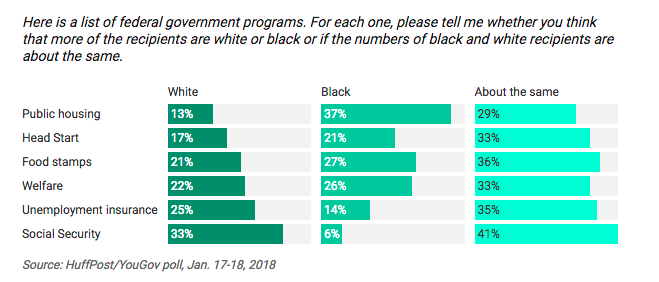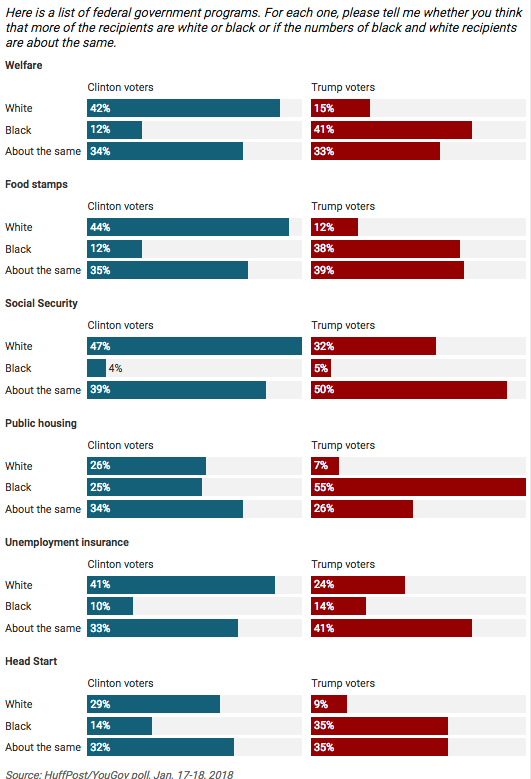What Is The Political Makeup Of Those On Welfare
WASHINGTON ― President Donald Trump and Republicans in Congress may soon commence on a racially-fraught policy battle over "welfare."
"We can lift our citizens from welfare, from dependence to independence, and from poverty to prosperity," Trump said in his Land of the Union address terminal week, the latest signal that Republicans want "welfare reform" this year.
Trump has oftentimes pandered to racists amongst his supporters. He said Mexico sends "rapists" to the United States and that there were some "fine people" among the neo-Nazis who staged a mortiferous protest last year in Charlottesville, Virginia. When the president said Mexican heritage made it impossible for a approximate to be fair, Firm Speaker Paul Ryan called it the "textbook definition" of racist.
The give-and-take "welfare" is unlike. It's a standard political term that Democrats, Republicans and journalists alike use ― though Republicans use it the near often. In that location's nothing overtly racialized about welfare. You lot tin can even find it in the preamble to the U.S. Constitution .
And yet, the word is oftentimes loaded with racial meaning. As a new HuffPost/YouGov survey shows , much of the public has a distorted view of which groups receive the bulk of assistance from government programs. Fifty-nine per centum of Americans say either that most welfare recipients are black, or that welfare recipiency is virtually the same among black and white people.

HuffPost
The numbers reflect a significant overestimation of the number of black Americans benefiting from the largest programs. Medicaid had more 70 million beneficiaries in 2016, of whom 43 percent were white, eighteen percent blackness, and thirty pct Hispanic. Of 43 million food stamp recipients that year, 36.two per centum were white, 25.6 percentage black, 17.2 pct Hispanic and 15.5 pct unknown. (Nutrient stamps are formally known as the Supplemental Nutrition Assistance Program.)
In one sense, HuffPost's survey asked an abstract question: The federal authorities doesn't run a plan that is actually called "welfare." The word can describe any instance of the authorities helping people or businesses, though information technology's most commonly used to describe programs that benefit the poor.
These days, to Republican lawmakers, welfare means Medicaid, food stamps and the Temporary Assistance for Needy Families program. Paul Ryan and hardline conservatives in the House of Representatives have said they want to make changes to those three programs this year under the imprint of welfare reform.
Historically, Temporary Assist for Needy Families is probably the program that has most frequently been chosen welfare, equally it was created in the famous "welfare reform" of 1996. Every bit a consequence of that reform, the plan today is much smaller than its predecessor, Aid to Families with Dependent Children, and information technology just served 2.vii million people in 2016. Of those, 36.ix per centum were Hispanic, 27.6 percent white, and 29.ane per centum black ― meaning that if they had this particular program in mind, HuffPost's survey respondents who said the number of white and black beneficiaries are "near the same" were basically right.
Survey respondents' estimation of who receives welfare tracked closely to their interpretation of who gets food stamps. Nearly two-thirds of poll respondents said the program's recipients are more often than not black or that there are as many black Americans as white Americans receiving benefits. Only 21 percent correctly said there are more white than blackness nutrient stamp recipients.
"Across the programs people overestimate the share of recipients who are black," said Elizabeth Lower-Basch, a senior annotator with the Centre for Law and Social Policy. "Information technology's non surprising considering we all know people'south images of public benefits is driven by stereotype."
Trump himself harbors mistaken views of who receives welfare benefits, according to reporting by NBC News. During a meeting with members of the Congressional Black Caucus final March, one fellow member of Congress told Trump that welfare cuts, which the president had proposed in his upkeep, would harm her constituents, specifying that not all of them were black.
According to NBC News , Trump said, "Actually? Then what are they?"
Trump supporters are also more than likely than Clinton voters to overestimate the share of welfare and public housing benefits that become to blackness recipients.

HuffPost
The perceptions of who benefits from programs may affect the favorability of the programs themselves. White Americans are more likely to support "aid to the poor" than "welfare," one 2014 study institute. And other polling has shown that whites are 30 points likelier to agree that "average Americans have gotten less than they deserve" than they are to say the same nearly black Americans.
Final yr, House Republicans and Trump signaled they wanted reforms to food stamps, specifically increased "piece of work requirements" that would deny benefits to the sliver of SNAP and Medicaid recipients who are able bodied but don't have jobs. Simply Senate Majority Leader Mitch McConnell (R-Ky.) suggested he didn't accept much interest in pursuing major changes to rubber net programs.
Even without McConnell's back up for a full-fledged reform of food stamps, Congress volition definitely have to consider the $70 billion program later this year because it needs to exist reauthorized.
Last week, Trump and Ryan talked about "workforce development," in what might be a new euphemism for Ryan'due south longstanding goal of shrinking the federal safety cyberspace. Ryan reportedly told swain Republicans at a GOP retreat in Due west Virginia terminal calendar week that workforce development means "getting people the skills and opportunity to get into the workforce."
Use the widget beneath to further explore the results of the HuffPost/YouGov survey, using the carte du jour at the top to select survey questions and the buttons at the bottom to filter the data by subgroups:
The HuffPost/YouGov poll consisted of 1,000 completed interviews conducted Jan. 17-18 amid U.S. adults, using a sample selected from YouGov'due south opt-in online panel to match the demographics and other characteristics of the adult U.S. population.
HuffPost has teamed up with YouGov to bear daily stance polls. You lot tin can larn more well-nigh this project and take role in YouGov's nationally representative opinion polling. More details on the polls' methodology are available here .
Most surveys study a margin of error that represents some, but non all, potential survey errors. YouGov'due south reports include a model-based margin of error, which rests on a specific set of statistical assumptions about the selected sample rather than the standard methodology for random probability sampling. If these assumptions are wrong, the model-based margin of error may likewise be inaccurate. Click here for a more than detailed explanation of the model-based margin of error.
Source: https://www.huffpost.com/entry/americans-welfare-perceptions-survey_n_5a7880cde4b0d3df1d13f60b
Posted by: edwardsaund1941.blogspot.com


0 Response to "What Is The Political Makeup Of Those On Welfare"
Post a Comment